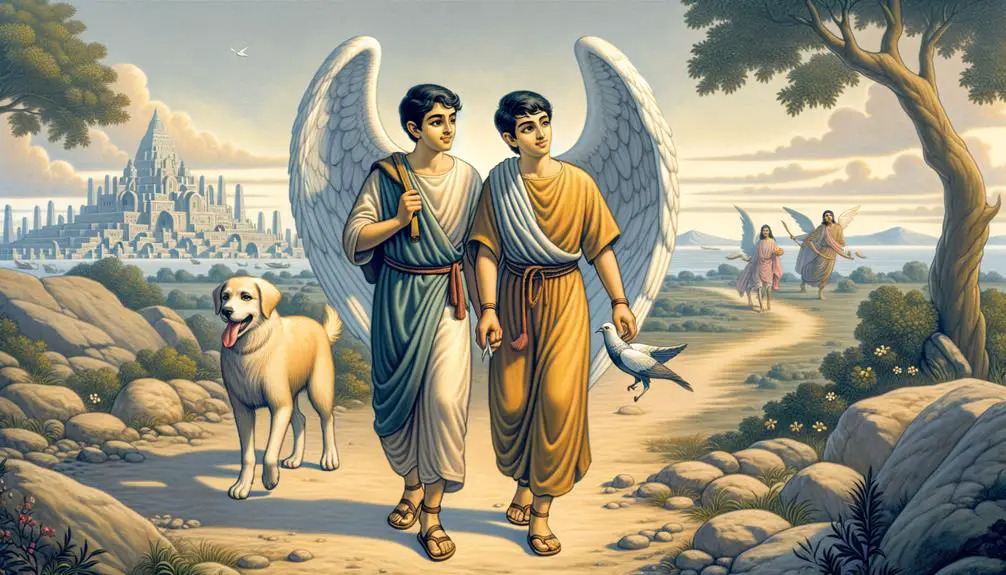Yield to curiosity and discover the hidden location of Tobias's tale in the Bible, unveiling a story of faith and divine mysteries.

Where Is the Story of Tobias in the Bible
Have you ever wondered where the story of Tobias fits within the biblical texts? You're not alone in your curiosity.
The narrative of Tobias, rich with spiritual themes and moral lessons, is found in the Book of Tobit, a text recognized in the Apocrypha. This section of scripture, though not universally accepted across all Christian denominations, offers profound insights into faith, family, and divine intervention.
Understanding its placement and significance could illuminate aspects of biblical history and spirituality that often go overlooked.
Let's embark on a journey to uncover the layers and implications of this intriguing story, exploring its historical context and its impact on Jewish tradition.
Key Takeaways
- The story of Tobias is found in the Book of Tobit in the Old Testament.
- It's included in the Catholic and Orthodox Bibles, but not in Protestant editions.
- The narrative revolves around Tobias' journey, angelic guidance, and themes of faith, marriage, and family.
- Tobit's story offers insights into Jewish tradition, moral values, and the importance of divine intervention.
The Book of Tobit Explained

The Book of Tobit, an apocryphal text found in the Old Testament, offers a profound narrative that intricately weaves themes of piety, righteousness, and divine providence into the life of its eponymous protagonist. You're drawn into a story that centers on Tobit, a man of steadfast faith, and his son Tobias. Their journey, enriched by angelic guidance, showcases the profound impact of celestial intermediaries in human affairs.
Delving deeper, the narrative provides you with an exceptional example of matrimonial advice, articulated through the experiences of Tobias under the mentorship of the angel Raphael. This angelic guidance isn't merely a supernatural intervention but serves as a conduit for imparting wisdom on navigating the complexities of relationships and the sanctity of marriage. Raphael, under the guise of a human companion, doesn't just lead Tobias to his future wife, Sarah, but also teaches him how to honor and preserve the sacred bond of matrimony. The instruction to marry for love and righteousness, rather than wealth or status, underscores the book's commitment to moral teachings.
Furthermore, the text intricately explores the dynamics of prayer, charity, and the importance of familial bonds, painting a holistic picture of a life led by divine guidance. The angel's role in providing matrimonial advice is emblematic of the broader theme of angelic intervention—serving as a reminder of the omnipresence of divine support in navigating life's trials and tribulations.
In essence, The Book of Tobit, through its exploration of angelic guidance and matrimonial advice, offers you a rich tapestry of spiritual and ethical teachings, emphasizing the intertwined nature of human choices and divine will.
Apocrypha: Understanding Its Role
Exploring the role of the Apocrypha sheds light on its significance within biblical literature and its impact on understanding stories like that of Tobias. The Apocrypha, a collection of texts not universally recognized within the canon of Scripture, often sparks canonical debates that delve into the heart of textual authenticity and authority. You'll find that these texts, including the Book of Tobit where the story of Tobias is recounted, occupy a unique space in the religious and cultural understanding of Scripture.
The Apocrypha's role transcends mere historical curiosity; it serves as a bridge between various traditions, highlighting the diversity of interpretation and belief within Christianity. Canonical debates surrounding these texts underscore the complexities of defining what's considered 'scripture' across different branches of Christianity. For instance, the Catholic and Orthodox churches include the Apocrypha in their Bibles, valuing these books for their theological and moral teachings, whereas most Protestant denominations do not, emphasizing the Hebrew Bible's canon.
Understanding the Apocrypha, therefore, isn't just about grappling with questions of textual authenticity; it's about appreciating the multifaceted nature of biblical interpretation. The discussions about what texts are included in the Bible illuminate the dynamic and evolving relationship between religious communities and their sacred texts.
Moreover, the Apocrypha, including stories like Tobias's, enriches the biblical narrative, offering additional perspectives and teachings that, while outside the narrower canon, still profoundly influence the faith and practice of millions. This makes the Apocrypha an indispensable tool for a more comprehensive understanding of biblical literature and its enduring impact.
Tobias' Journey: An Overview

Within the narrative arc of the Apocrypha, Tobias' journey emerges as a pivotal exploration of faith, obedience, and divine intervention, deeply enriching our understanding of biblical themes. Accompanied by the Angel Raphael, disguised as a human companion, Tobias embarks on a series of events that underscore the complexities and divine guidance within human lives. This journey isn't just a physical trek but a spiritual odyssey that intertwines with themes of healing, marriage, and divine purpose.
To paint a picture of Tobias' quest:
- Guidance by the Angel Raphael: Disguised as a human, Raphael guides Tobias, illustrating the unseen divine presence and intervention in human affairs.
- Retrieval of Fish's Heart, Liver, and Gall: A testament to the peculiar, yet profound divine instructions, these items play crucial roles in Tobias' journey, signifying the intersection of faith and action.
- Marriage Proposal to Sarah: Amidst his journey, Tobias is led to Sarah, whose previous marriages were tormented by a demon. His proposal, encouraged by Raphael, marks a pivotal moment of faith and divine orchestration.
- Healing of Tobias' Father: Utilizing the fish's gall, Tobias heals his father's blindness, symbolizing the restoration and blessings that follow obedience and faith.
Tobias' journey, punctuated by the Angel Raphael's presence and the marriage proposal to Sarah, serves as a profound narrative of divine engagement with humanity. This story, nestled within the Apocrypha, offers a detailed exploration of the complexities of faith, the nuances of divine commands, and the depth of divine love and guidance.
Spiritual Themes and Messages
Delving into the spiritual themes and messages of Tobias' story reveals a tapestry of divine intervention, faith-driven actions, and moral guidance that resonate deeply with readers seeking understanding and inspiration. At its core, this narrative underscores the profound impact of divine intervention in human affairs, illustrating how celestial guidance shapes the outcomes of our earthly journeys. You're invited to explore how angelic presence, specifically through the character of Raphael, not only orchestrates the events of Tobias' quest but also imparts critical wisdom and protection.
Moreover, the story serves as a rich source of moral lessons, emphasizing virtues like loyalty, humility, and the power of prayer. You'll find that Tobias' unwavering faith and adherence to these virtues play a pivotal role in overcoming the trials he faces. This aspect of the narrative prompts you to reflect on the importance of maintaining faith and integrity, even in the face of adversity.
Additionally, the story's emphasis on familial duty and the sanctity of marriage offers profound insights into the moral fabric of ancient societies, yet these themes remain deeply relevant today. You're encouraged to consider how these timeless values influence your own life and relationships.
In dissecting the spiritual themes and messages of Tobias' story, you engage with a narrative that not only enlightens but also challenges you to ponder the essence of divine intervention and the moral lessons embedded within. This analytical journey through Tobias' story enriches your understanding of its spiritual significance, leaving a lasting imprint on your perception of faith and moral conduct.
Historical Context and Significance

Having examined the spiritual layers of Tobias' story, it's crucial to anchor these insights within its historical framework to fully appreciate its significance. The narrative doesn't just offer moral and spiritual teachings; it also serves as a window into the life and times of its characters, shaped by their geographical setting and the cultural influences of their era. To get a fuller picture, consider the following factors:
- Cultural Influences: The story of Tobias, also known as Tobit, is steeped in the rich tapestry of Near Eastern cultures. The interactions between Jewish and non-Jewish communities are evident, reflecting a period of significant cross-cultural exchanges. These influences are seen in the rituals, beliefs, and daily practices depicted in the narrative.
- Geographical Setting: The journey of Tobias takes place against a backdrop that spans several key locations in the ancient Near East. This geographical setting isn't just a stage for the story's events but also shapes the experiences and challenges faced by the characters.
- Historical Events: The narrative is set during a tumultuous period of Jewish history, marked by exile and displacement. This context is crucial for understanding the themes of faith, providence, and restoration that run through the story.
- Socio-Political Context: The story reflects the socio-political dynamics of its time, including the pressures faced by Jewish communities living under foreign rule. This backdrop adds depth to the characters' struggles and triumphs, making their faith and resilience even more poignant.
Understanding these elements enriches your appreciation of the story's place within the broader tapestry of human history and culture.
Variations Across Biblical Canons
The story of Tobias exhibits notable variations across different biblical canons, which reflect the complex process of scriptural development and the diverse theological perspectives within Judaism and Christianity. You'll find that canon inclusion and textual differences are central to understanding these variations. The Catholic and Orthodox Churches include the Book of Tobit (the story of Tobias) in their biblical canon, recognizing it as deuterocanonical scripture. Conversely, Protestant Bibles typically omit this book, relegating it to the Apocrypha, indicating a nuanced stance on its authoritative status.
Textual differences further complicate the picture. The ancient manuscripts of Tobit reveal variations in language, length, and content. For instance, the Greek texts, which are shorter, and the longer Latin versions, suggest a dynamic tradition of transmission and adaptation. These discrepancies hint at the multifaceted nature of its textual history, shaped by the communities that read, copied, and cherished these narratives.
Moreover, the Eastern Orthodox Church, while including Tobit in its canon, often relies on the Septuagint version—a Greek translation of Hebrew scriptures that predates the Latin Vulgate. This choice underscores the significance of linguistic and cultural contexts in shaping scriptural understanding.
In analyzing the story of Tobias within the broader biblical landscape, it's crucial to appreciate how canon inclusion and textual differences embody the theological, liturgical, and moral priorities of diverse faith communities. These variations aren't mere historical footnotes but are reflective of the evolving relationship between scripture, tradition, and the quest for religious identity and truth.
The Impact on Jewish Tradition

Understanding the variations across biblical canons, it's crucial to explore how the story of Tobias has influenced Jewish tradition, reflecting on its cultural and theological ramifications. The narrative, though not universally recognized in every Jewish text, has still permeated aspects of Jewish life, integrating into ritual practices and shaping community roles. Its impact can be seen in:
- Ritual Practices: The story of Tobias has underscored the importance of charity, prayer, and burial rites within Judaism. Its teachings have subtly woven into the fabric of Jewish ritual life, reinforcing the value of these practices not just as religious duties but as moral imperatives.
- Community Roles: Tobias's narrative offers a model for communal responsibility and care, emphasizing the importance of looking after the less fortunate and the sick. This ethos has been integral in shaping the roles individuals play within their communities, fostering a sense of collective responsibility.
- Theological Discussions: The story has been a point of reference in theological debates regarding angels, divine intervention, and the nature of righteousness. Its narrative components contribute to a rich tapestry of Jewish theological thought, inviting interpretation and discussion.
- Literary and Cultural Influence: Beyond its religious implications, the story of Tobias has found its way into Jewish literature and folklore, inspiring a myriad of interpretations and retellings. It serves as a cultural touchstone, reflecting and informing Jewish values, ethics, and identity.
Through these aspects, the story of Tobias has had a lasting impact on Jewish tradition, illustrating how texts, even when not canonical for all, can deeply influence cultural and religious practices and beliefs.
Frequently Asked Questions
How Has the Story of Tobias Influenced Modern Literature and Culture Outside of Religious Texts?
You've noticed that the story of Tobias has significantly impacted modern literature and culture, manifesting in various theatrical adaptations and cinematic interpretations. These artistic renditions explore themes of faith, guidance, and divine intervention, subtly influencing contemporary storytelling.
Are There Any Notable Artworks, Such as Paintings or Sculptures, Inspired by the Story of Tobias?
Diving into the digital age, you'll find the story of Tobias has inspired a plethora of artworks across various artistic mediums.
Notably, paintings and sculptures stand out, capturing the narrative's essence.
These pieces often undergo meticulous restoration techniques to preserve their historical and cultural significance.
Analyzing them reveals a deep scholarly appreciation for the story's impact, showcasing how ancient tales continue to influence modern artistic expressions in detailed and profound ways.
How Do Different Religious Denominations View the Moral Lessons Taught in the Story of Tobias Today?
You'll find that different religious denominations draw various moral lessons from the story of Tobias, influenced by ecumenical interpretations and denominational teachings. These perspectives often emphasize the virtues of faith, charity, and family loyalty.
Analyzing these teachings reveals a rich tapestry of beliefs that, despite their diversity, share a common appreciation for the story's moral guidance. This analysis highlights the story's ability to bridge doctrinal differences through shared ethical values.
Can Parallels Be Drawn Between the Story of Tobias and Myths or Stories From Other Ancient Cultures?
Absolutely, you can draw parallels between Tobias's tale and myths from other ancient cultures. Like a mirror reflecting a hero's journey across civilizations, Tobias's adventures resonate with cultural symbolism found in countless narratives.
These stories, rich in moral and spiritual quests, share common themes of overcoming adversity, divine guidance, and personal growth.
Analyzing these parallels offers a scholarly lens into how different societies articulate similar human experiences through their unique mythological frameworks.
What Are the Psychological Interpretations of the Characters and Their Journeys in the Story of Tobias?
You'll find the psychological interpretations of the characters and their journeys in Tobias's story deeply rooted in archetypal roles and healing symbolism.
Analyzing these elements reveals how each character embodies universal themes of growth, redemption, and transformation.
The narrative intricately weaves psychological insights with ancient wisdom, offering a rich tableau for understanding human nature and the process of healing.
This analytical lens provides a detailed exploration of their symbolic journeys.
Conclusion
In conclusion, you've navigated through the intricate tapestry of the Book of Tobit, uncovering its rich layers from its apocryphal status to its profound spiritual messages.
Delving into Tobias' journey, you've explored the historical depth and the variances across biblical canons, recognizing its unique impact on Jewish tradition.
Remarkably, despite its ancient roots, Tobit's narrative remains relevant, akin to finding an old manuscript on a modern e-reader, illustrating timeless themes of faith, family, and divine intervention.



Sign up